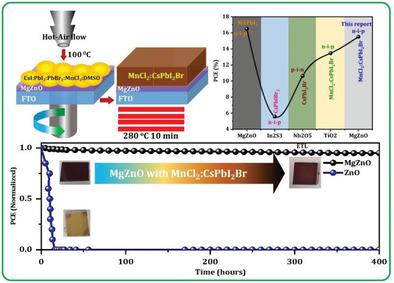当前位置:
X-MOL 学术
›
Adv. Energy Mater.
›
论文详情
Our official English website, www.x-mol.net, welcomes your feedback! (Note: you will need to create a separate account there.)
Simultaneous Improved Performance and Thermal Stability of Planar Metal Ion Incorporated CsPbI2Br All‐Inorganic Perovskite Solar Cells Based on MgZnO Nanocrystalline Electron Transporting Layer
Advanced Energy Materials ( IF 27.8 ) Pub Date : 2019-12-02 , DOI: 10.1002/aenm.201902708 Sawanta S. Mali 1 , Jyoti V. Patil 1 , Chang Kook Hong 1
Advanced Energy Materials ( IF 27.8 ) Pub Date : 2019-12-02 , DOI: 10.1002/aenm.201902708 Sawanta S. Mali 1 , Jyoti V. Patil 1 , Chang Kook Hong 1
Affiliation

|
The high thermal stability and facile synthesis of CsPbI2Br all‐inorganic perovskite solar cells (AI‐PSCs) have attracted tremendous attention. As far as electron‐transporting layers (ETLs) are concerned, low temperature processing and reduced interfacial recombination centers through tunable energy levels determine the feasibility of the perovskite devices. Although the TiO2 is the most popular ETL used in PSCs, its processing temperature and moderate electron mobility hamper the performance and feasibility. Herein, the highly stable, low‐temperature processed MgZnO nanocrystal‐based ETLs for dynamic hot‐air processed Mn2+ incorporated CsPbI2Br AI‐PSCs are reported. By holding its regular planar “n–i–p” type device architecture, the MgZnO ETL and poly(3‐hexylthiophene‐2,5‐diyl) hole transporting layer, 15.52% power conversion efficiency (PCE) is demonstrated. The thermal‐stability analysis reveals that the conventional ZnO ETL‐based AI‐PSCs show a serious instability and poor efficiency than the Mg2+ modified MgZnO ETLs. The photovoltaic and stability analysis of this improved photovoltaic performance is attributed to the suitable wide‐bandgap, low ETL/perovskite interface recombination, and interface stability by Mg2+ doping. Interestingly, the thermal stability analysis of the unencapsulated AI‐PSCs maintains >95% of initial PCE more than 400 h at 85 °C for MgZnO ETL, revealing the suitability against thermal degradation than conventional ZnO ETL.
中文翻译:

基于MgZnO纳米晶电子传输层的平面金属离子结合CsPbI2Br全无机钙钛矿太阳能电池的同时提高的性能和热稳定性
CsPbI 2 Br全无机钙钛矿太阳能电池(AI-PSC)的高热稳定性和简便的合成方法引起了人们的极大关注。就电子传输层(ETL)而言,低温处理和通过可调能级减少的界面复合中心决定了钙钛矿设备的可行性。尽管TiO 2是PSC中使用最广泛的ETL,但其加工温度和适度的电子迁移率会影响其性能和可行性。本文中,针对动态热风处理的Mn 2+的高度稳定,低温处理的MgZnO纳米晶基ETL。据报道有结合的CsPbI2Br AI-PSC。通过保持其规则的平面“ n–i–p”型器件架构,MgZnO ETL和聚(3-己基噻吩-2,5-二基)空穴传输层可实现15.52%的功率转换效率(PCE)。热稳定性分析表明,与基于Mg 2+修饰的MgZnO ETL相比,基于ZnO ETL的传统AI-PSC具有严重的不稳定性和较差的效率。光伏性能的改善以及对光伏性能和稳定性的分析归因于合适的宽带隙,低ETL /钙钛矿界面复合以及Mg 2+对界面的稳定性掺杂。有趣的是,对于MgZnO ETL,未封装的AI-PSC的热稳定性分析在85°C下超过400小时保持超过95%的初始PCE,这表明它比常规ZnO ETL更适合热降解。
更新日期:2020-01-22
中文翻译:

基于MgZnO纳米晶电子传输层的平面金属离子结合CsPbI2Br全无机钙钛矿太阳能电池的同时提高的性能和热稳定性
CsPbI 2 Br全无机钙钛矿太阳能电池(AI-PSC)的高热稳定性和简便的合成方法引起了人们的极大关注。就电子传输层(ETL)而言,低温处理和通过可调能级减少的界面复合中心决定了钙钛矿设备的可行性。尽管TiO 2是PSC中使用最广泛的ETL,但其加工温度和适度的电子迁移率会影响其性能和可行性。本文中,针对动态热风处理的Mn 2+的高度稳定,低温处理的MgZnO纳米晶基ETL。据报道有结合的CsPbI2Br AI-PSC。通过保持其规则的平面“ n–i–p”型器件架构,MgZnO ETL和聚(3-己基噻吩-2,5-二基)空穴传输层可实现15.52%的功率转换效率(PCE)。热稳定性分析表明,与基于Mg 2+修饰的MgZnO ETL相比,基于ZnO ETL的传统AI-PSC具有严重的不稳定性和较差的效率。光伏性能的改善以及对光伏性能和稳定性的分析归因于合适的宽带隙,低ETL /钙钛矿界面复合以及Mg 2+对界面的稳定性掺杂。有趣的是,对于MgZnO ETL,未封装的AI-PSC的热稳定性分析在85°C下超过400小时保持超过95%的初始PCE,这表明它比常规ZnO ETL更适合热降解。


























 京公网安备 11010802027423号
京公网安备 11010802027423号